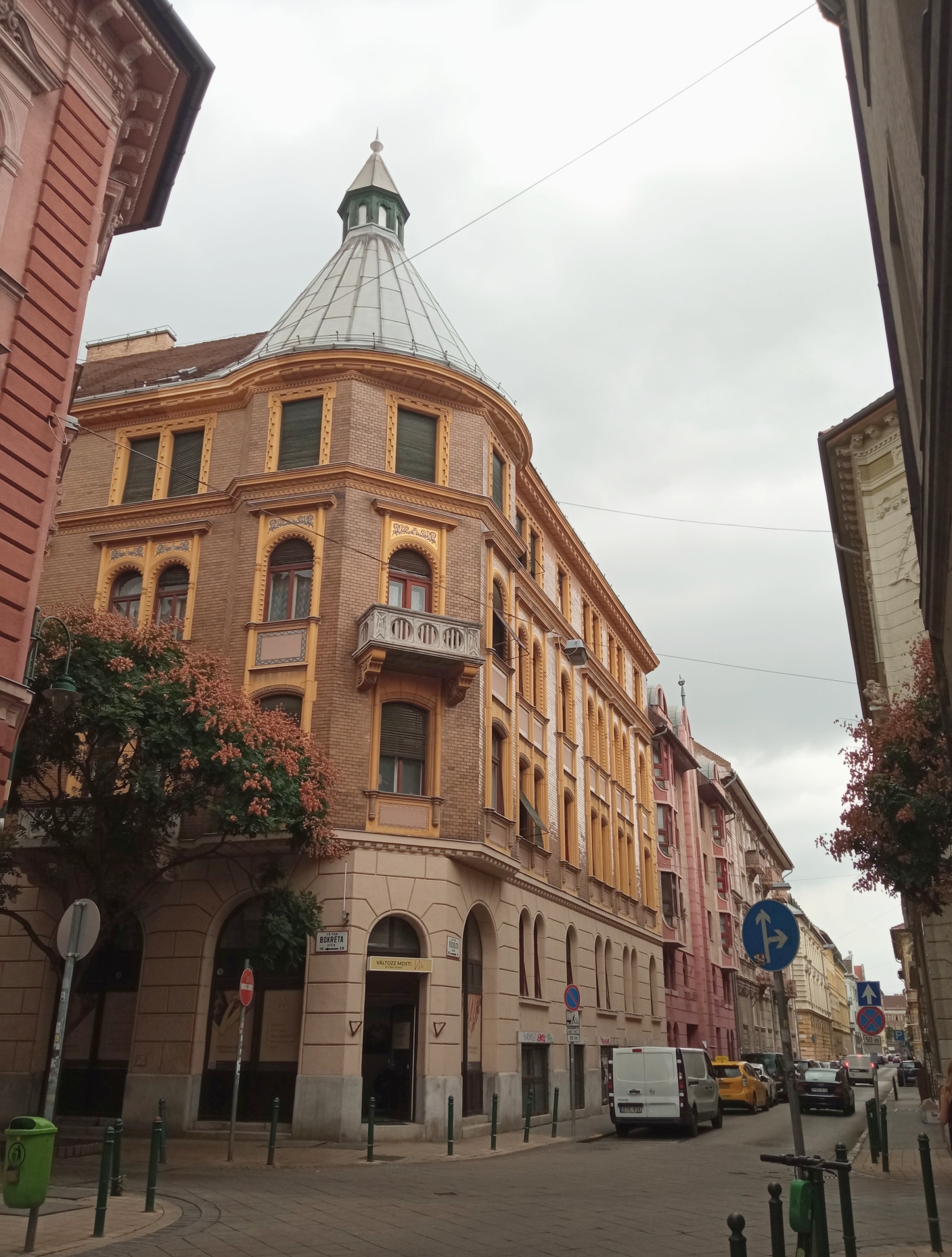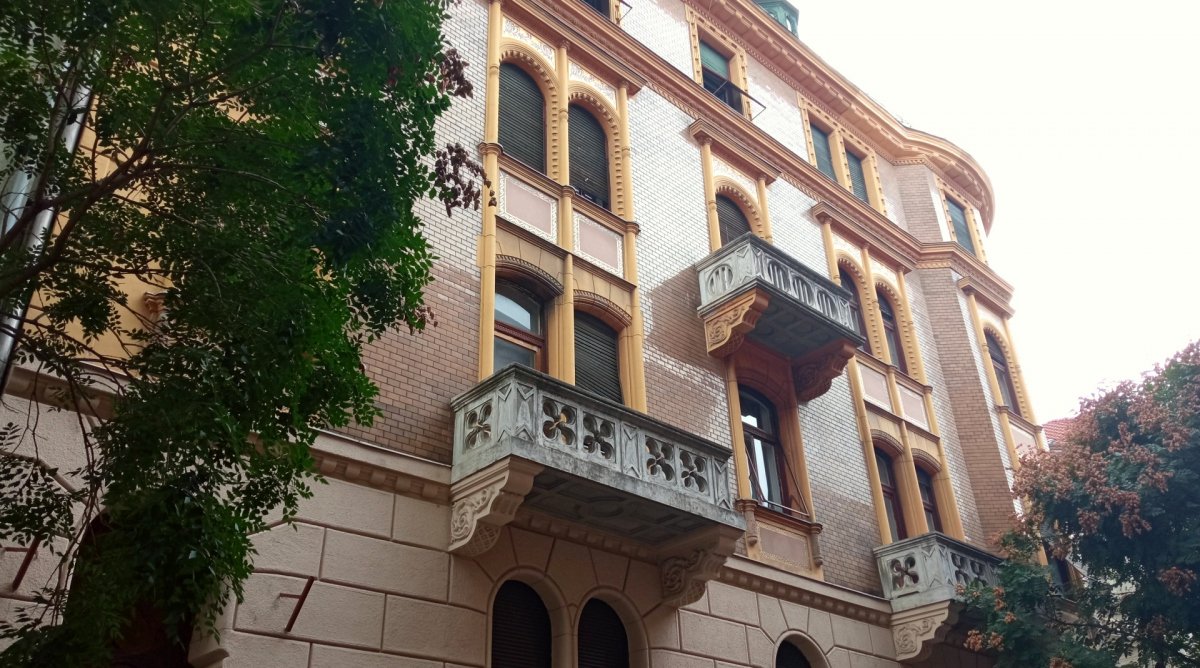The founder of the dynasty, Lajos Zupka, was born in Majosháza in Pest County in 1852, and learned the tricks of blacksmithing from his father. He moved to Budapest in 1880, and in 1886 he had enough capital to open his own blacksmith shop at 25 Tűzoltó Street. At the turn of the century, he expanded his activities and also tried his hand at the production of carriages. In recognition of his horse-drawn carriages, waggons and other horse-drawn vehicles, he was awarded the Millennium Grand Medal at the Millennium Exhibition in 1896.

Corner facade of 28 Bokréta Street (Photo: Tímea Simon)
At the beginning of the 1900s, he also got involved in automobile production, but his son, Lajos Zupka Jr., developed this, or rather vehicle body building, to a master degree. He studied technical drawing and body building in Paris. In 1922, he and his father founded the Lajos Zupka and Son Vehicle Body Factory, at which time they were no longer only involved in the superstructures of passenger cars, but also commercial vehicles.
In the 1930s, the company received numerous domestic and international recognitions and prestigious awards. From 1925, they took part in the Budapest automobile exhibition every year, where in 1928 they won a silver plaque at the Concours d'Elegance car beauty contest organized following French antecedents. In 1930, at the same competition, one of their cars was awarded a grand prize with a gold ribbon, and in 1935, an audience prize.

The Mercedes-Benz S sports car that won the audience’s award in the 1 May 1935 issue of the magazine Auto-Traktor
In 1932, their bodywork, built on the chassis of Archduke Joseph Habsburg's Mercedes-Benz car, was so successful that the company manager was awarded the title of court transporter. By the way, even before the work was completed, the archduke visited the Zupkas at the Tűzoltó Street site and looked at the car being made with interest.

Archduke Joseph inspects the audience prize-winning car (Source: Auto-Traktor, 1 May 1935)

Lajos Zupka receives the audience's award (Source: Auto-Traktor, 1 May 1935)
In the 1930s, bodies were built on the chassis of not only Mercedes, but also Minerva, Fiat and Hotchkiss cars in the factory, where at the same time bus bodies were also produced in larger numbers. A significant part of the bodywork of Budapest buses was made here, and from 1940 they were also able to produce ski cars..

Zupka's bus body in the 1 June 1934 issue of the magazine Auto-Traktor
At this time, the third generation, the youngest Lajos Zupka and his sister Margit Zupka, were already involved in the management of the company. From 1945, they had to deal with the repair of Soviet military vehicles for a while, but this did not save the company founded 60 years ago. In 1949, the company reached the fate of nationalization, and the plant at 25 Tűzoltó Street continued to operate under the name No. 5 National Car Repair Company. The family members decided to emigrate one after the other, and in 1956 the last Zupka also fled abroad.

The interior of the plant from the 15 May 1955 issue of Autó-Motor

The interior of the plant in the 21 April 1971 issue of Autó-Motor

The former Zupka factory around 1990 (Source: Ferencváros Local History Collection)

The residential building on the site of the Zupka factory in 2022 (Photo: Tímea Simon)
Now let's return to the apartment building, because it really deserves a closer look. The two street facades are perhaps the most valuable part. Two large laced stone balconies rise from the first floor of the facade facing Bokréta Street, on the second floor there is only one balcony, but here the windows have particularly nice closings. On the one hand, they evoke a neo-Gothic atmosphere, and on the other hand, the arch is decorated with flower pattern mosaics.
The windows on the third floor have a geometric pattern, so each floor offers something new to the beholder. The designer of the house was János Bach, who also perfectly solved the task of making it possible for the buyer to enter the basement from the neatly squared ground floor - since there are rooms suitable for workshops and shops here.

The facade of the house on Bokréta Street (Photo: Tímea Simon)

The facade on Tűzoltó Street (Photo: Tímea Simon)

Painted mosaics: the geometric shapes and floral patterns change from level to level (Photo: Tímea Simon)
.jpg)

The wrought iron railings harmonize beautifully with the decoration of the windows and doors (Photo: Tímea Simon)
Looking carefully at the inner courtyard covered with ceramic tiles, the same turn-of-the-century atmosphere overwhelms the viewer as outside on the street. The elegant wrought iron railings, the front doors of the apartments and the window frames have all survived the trials of the past 110 years and are in very good condition thanks to the cooperation of the residents. The stucco and mosaic decorations on the ceiling of the vestibule were also restored according to the original designs and colour patterns.
Standing in the middle of the courtyard, one feels as if one has flown back to the early 1910s. The only modern addition is the external elevator, which was built next to the shorter part of the building. Another change is the courtyard of the residential building built on the site of the former factory, which provides a common green surface for the residents of the other buildings of the residential block.

From a height of three floors (Photo: Tímea Simon)

At the end of the yard is the modern elevator, in the background is the internal green area shared with the other houses (Photo: Tímea Simon)
If older, younger and youngest Lajos Zupka were to visit their house today by magic, they would surely thank the residents for carefully preserving everything that was once their property. Bokréta Street 28 is a great example of how it is possible to create spaces and apartment interiors that meet modern needs by preserving the old architecture.



More details from the house (Photo: Tímea Simon)
Cover Photo: 110-year-old jewel-box in Bokréta Street (Photo: Tímea Simon)




































Hozzászólások
Log in or register to comment!
Login Registration